
|
Sale 114
The New York Sale
| Lot |
Photo |
Description |
Bidding |
Lot 229 |
 |
Trajan. Æ Dupondius (13.38 g), AD 98-117. Rome, AD 116/7. IMP CAES NER TR[AIANO OPTIMO AV]G GER DAC P M TR P COS [VI P P], radiate and draped bust of Trajan right. Reverse: SE[NATV]S POPVLVSQVE ROMANVS, S C in exergue. Emperor in military dress, facing, head left, striding right between two trophies, raising hand in address and holding spear. RIC 676; Woytek 586v; BMC 1053. Handsome uniform green patina. Choice Very Fine. Value $750 - UP
View details and enlarged photos
|
|
Lot 230 |
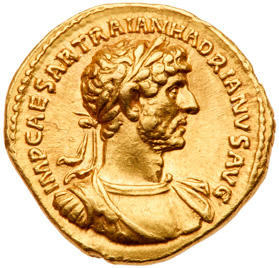 |
Hadrian. Gold Aureus (7.13 g), AD 117-138. Mint of Rome, struck AD 118. IMP CAESAR TRAIA-N HADRIANVS AVG, laureate, draped and cuirassed bust of Hadrian right. Reverse: P M TR P COS II around, CONCORD in exergue, Concordia seated left, holding patera and resting arm on statue of Spes set on low column; below throne, cornucopiae. RIC 39a; BMC 60; Calicó 1205. Lovely style. and lustrous surfaces. Superb Extremely Fine. Value $8,000 - UP
View details and enlarged photos
|
|
Lot 231 |
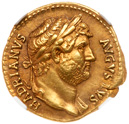 |
Hadrian. Gold Aureus (7.40 g) AD 117-138. Mint of Rome struck AD 124-8. HADRIANVS AVGVSTVS, laureate bust facing right, with slight drapery on left shoulder. Reverse:. COS III, Hadrian on horse prancing left, raising his right head and holding a spear (RIC 188 var.; Calicó 1229 (this reverse die); Biaggi 596 var.; BMC p. 294, note 439). Fine Style, with a very rare reverse type, an impressive coin. Attractively toned over lustre. NGC graded AU*, Strike 5/5 Surface 4/5, Fine Style. Value $15,000 - UP
View details and enlarged photos
|
|
Lot 232 |
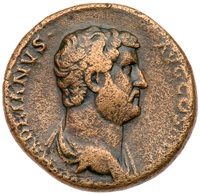 |
Hadrian. Æ Sestertius (24.19 g), AD 117-138. Rome, ca. AD 134-138. HADRIANVS AVG COS III P P, bare-headed and draped bust of Hadrian right. Reverse: ADVENTVI AVG IVDAEAE, S C in exergue, Hadrian, togate, standing right, holding roll and facing Judaea standing left, sacrificing out of patera over altar; at either side of Judaea, child standing left, holding palm branch; behind altar, bull recumbant left. Hendin 1604; RIC 890c; BMC 1655. Rare. Excellent detail and quite pleasing. Brassy and tan patina. Very Fine. Value $3,000 - UP
Hadrian traveled extensively throughout the Roman provinces during his reign, and struck an number of reverse types to commemorate each province he visited. These highly collectible coins are generally referred to by numismatists as Hadrian's "Travel Series.' One of the most difficult to obtain of the entire series - and probably the rarest of these commemorative coins - honors the province of Judaea, which Hadrian visited in the summer of AD 130. The reverse depicts the emperor facing Judaea, who is the act of sacrificing at an altar flanked by a bull. It is particularly poignant as it alludes the loyalty of the province to the central government in Rome. It is not known whether this type dates immediately to Hadrian's visit in AD 130 or perhaps later, either during or after the outbreak of the Bar Kokhba Revolt (AD 132-135), but here we follow the dating of AD 134-138 proposed by Mattingly and Sutherland in RIC II.
Ex Mel Wacks Collection; Purchased from Christian Blom of New York, 1960s.
View details and enlarged photos
|
|
Lot 233 |
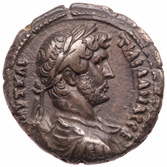 |
Hadrian, with Sabina. BI Tetradrachm (13.32 g), AD 117-138. Struck in Alexandria, Egypt, RY 13 (AD 128/9). Laureate, draped, and cuirassed bust of Hadrian right. Reverse: Diademed and draped bust of Sabina right; behind, date (L IΓ). Köln 997; Dattari (Savio) 1249; Kampmann & Ganschow 32.469. Wonderful high relief style and superb details. Extremely Fine. Value $4,000 - UP
View details and enlarged photos
|
|
Lot 234 |
 |
Antinous, favorite of Hadrian, AE Hemidrachm (28 mm) (14.76 g). Alexandria in Egypt, RY 19 of Hadrian (AD 130). ANTINOOV [HPωOC], draped bust of Antinoüs right, wearing hem�hem crown. Reverse: Antinoüs, cloaked and holding caduceus, on horseback right; across lower field, date (L/I-Θ). Cf. Köln 1277; Dattari (Savio) 8007-9; Kampmann & Ganschow 34a.2; Blum 9; Emmett 1347 (R3). Very Rare. Brown patina. NGC grade VF*; Strike: 4/5, Surface: 4/5. Value $4,000 - UP
Ex Gorny & Mosch, Sale 237, #1694.
View details and enlarged photos
|
|
Lot 235 |
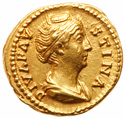 |
Diva Faustina I. Gold Aureus (7.15 g), died AD 140/1. Rome, under Antoninus Pius, after ca. AD 146. DIVA FAVSTINA, diademed and draped bust of Faustina I right. Reverse: AETER-NITAS, Fortuna standing facing, head left, holding patera and rudder on globe. RIC 349a; BMC 371; Calicó 1743b. Boldly struck in high relief. Lustrous surfaces. Nearly Mint State. Value $5,000 - UP
View details and enlarged photos
|
|
Lot 236 |
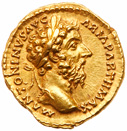 |
Marcus Aurelius. Gold Aureus (7.27 g), AD 161-180. Rome, AD 168. M ANTONINVS AVG ARM PARTH MAX, laureate head of Marcus Aurelius right. Reverse: TR P XXIII IMP V COS III, Aequitas standing left, holding scales and cornucopiae. RIC 189; Szaivert 165-14/30; BMC 465; Calicó 2005. Boldly struck in high relief and lustrous. Nearly Mint State. Value $15,000 - UP
View details and enlarged photos
|
|
Lot 237 |
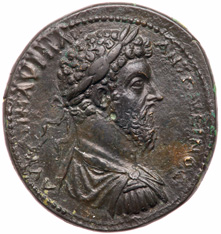 |
Marcus Aurelius. Æ 34 (23.34 g), AD 161-180. Pergamum in Mysia. Ti. Claudius Aristeon, magistrate. [A]V KAI M AVPHΛI ANTΩNEINO? Laureate, draped and cuirassed bust of Marcus Aurelius right. Reverse: EΠI CTPA T KΛAV APICTEOV ΠEPΓAMHNΩN B NEOKoPΩN, Zeus seated left, holding Nike and scepter. RPC temp. 3228.2 (this coin); Weisser 950; BMC 288. Uniform glossy chocolate brown patina. Extremely Fine / Choice Very Fine. Value $3,000 - UP
Ex Nomos 6 (8 May 2012), 148; Ex Gorny & Mosch 133 (11 October 2004), 320.
View details and enlarged photos
|
|
Lot 238 |
 |
Pertinax. Silver Denarius (2.96 g), AD 193. Rome. IMP CAES P HELV PERTIN AVG, laureate head of Pertinax right. Reverse: AEQVIT AVG TR P COS II, Aequitas standing facing, head left, holding scales and cornucopiae. RIC 1; BMC 15; RSC 2. Wonderful expressive portrait. Lightly toned. Extremely Fine. Value $2,000 - UP
View details and enlarged photos
|
|
Lot 239 |
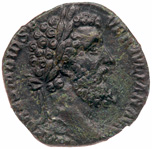 |
Didius Julianus, AE Sestertius (17.76 g) AD 193. Rome. IMP CAES M DID SEVER IVLIAN AVG, laureate head of Didius Julianus right. Reverse: [P M T]R P COS, S C across field, Fortuna standing facing head left, holding rudder set on globe and cornucopiae. RIC 15. Pleasing dark reddish-brown patina. NGC grade Ch XF; Strike: 4/5, Surface: 4/5. Light smoothing. Value $2,500 - UP
View details and enlarged photos
|
|
Lot 240 |
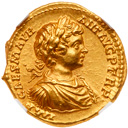 |
Caracalla. Gold Aureus (7.27 g). Mint of Rome, struck AD 198. IMP CAES M AVR ANT AVG P TR P, laureate, draped and cuirassed bust facing right, wearing aegis. Reverse: SPES PVBLICA, Spes advancing left, holding a flower and raising drapery (RIC 26b; Calicó 2820; Biaggi 1202; C 598). With a very attractive bust type of fine style, well-struck and lustrous. A superb example. NGC graded MS, Strike 5/5 Surface 4/5 Fine Style. Value $25,000 - UP
View details and enlarged photos
|
|
Lot 241 |
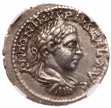 |
Elagabalus. Silver Denarius (3.23 g), AD 218-222. Antioch, AD 218/9. ANTONINVS PIVS FEL AVG, laureate, draped and cuirassed bust of Elagabalus right. Reverse: SANCT DEO S-OL-I around, ELAGABAL in exergue, the Holy Stone (baetyl) of Emesa flanked by four parasols, on triumphal car drawn by four horses right. RIC 195; BMC 284; RSC 268. Rare. Lightly toned. NGC grade Ch XF; Strike: 4/5, Surface: 4/5. Value $2,500 - UP
Born in AD 205, Varius Avitus Bassianus, grandson of Julia Maesa and neice of the empress Julia Domna, was appointed High Priest of Baal of Emesa in his boyhood. In 218 he was proclaimed emperor by the Legions stationed in Syria. This uprising ended with the assassination of Macrinus and Diadumenian. Elagabalus left for Rome taking with him the cult statue of Baal, the Holy Stone of Emesa. In Rome, he made Sol Heliogabalus the first god of the Roman pantheon. The cult statue had its home in the Eliogabalium on the Palatine. The reign of Elagabalus was characterized by his religious fanaticism and other eccentricities which eventually led to his assassination by the Pretorians in AD 222.
View details and enlarged photos
|
|
Lot 242 |
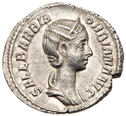 |
Orbiana. Silver Denarius (2.63 g), Augusta, AD 225-227. Rome, under Severus Alexander, AD 225. SALL BARBIA ORBIANA AVG, diademed and draped bust of Orbiana right. Reverse: CONCORDI-A AVGG, Concordia seated left, holding patera and double cornucopiae. RIC 319; BMC 287-90; RSC 1. Lightly toned. Superb Extremely Fine. Value $700 - UP
Ex NAC 40 (16 May 2007), 793.
View details and enlarged photos
|
|
Lot 243 |
 |
Maximinus I 'Thrax'. Æ 35 (21.06 g), AD 235-238. Tarsus in Cilicia. Laureate, draped and cuirassed bust of Maximinus I right. Reverse: The Three Graces standing, the central figure seen from behind, embracing each other, those on ends holding flowers. SNG BN 1605 (same dies); cf. SNG Levante 1096; Staal 36.1.1. Brown patina. NGC grade Ch F; Strike: 5/5, Surface: 3/5. Value $1,000 - UP
Ex Dr. Mark Staal Collection of the Three Graces.
View details and enlarged photos
|
|
Lot 244 |
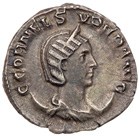 |
Cornelia Supera. Silver Antoninianus (3.71 g), Augusta, AD 253. Rome, under Aemilian. C CORNEL S-VPERA AVG, diademed and draped bust of Cornelia Supera right, set on a crescent. Reverse: VESTA, Vesta standing facing, head left, holding patera and scepter. RIC 30; RSC 5. Extremely Rare. Uniform antique cabinet toning. Choice Very Fine. Value $15,000 - UP
Other than the fact that she was the wife of the short-reigned emperor Aemilian and that she was of the Cornelia gens, nothing is known about the empress Cornelia Supera.
Ex Künker 243 (21 November 2013), 5103.
View details and enlarged photos
|
|
Lot 245 |
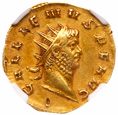 |
Gallienus, Gold Aureus (4.32 g.) AD 253-268. Mint of Rome, AD 262. GALLIENVS P F AVG, radiate head of Gallienus right. Reverse: FIDE/I EQI/TVM in three lines within laurel wreath. RIC -; Calicó 3501a. Extremely Rare. NGC grade Ch XF; Strike: 5/5, Surface: 3/5. Scratches. Value $8,000 - UP
View details and enlarged photos
|
|
Lot 246 |
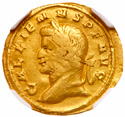 |
Gallienus, Gold Aureus (5.35 g) 253-268 AD. Mint of Mediolanum, struck AD 262. GALLIENVS P F AVG, laureate head of Gallienus left. Reverse: FIDES/MILI/TVM in three lines within laurel wreath. RIC 33 (Rome); Göbl 1070c; Calicó 3488. Very Rare. NGC grade F; Strike: 4/5, Surface: 2/5. Damage. Value $5,000 - UP
A very rare type, minted at Mediolanum (Milan), which boasts the loyalty of the Roman cavalry.
Ex NAC O (11 May 2004), 2092.
View details and enlarged photos
|
|
Lot 247 |
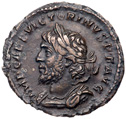 |
Victorinus. Æ Denarius (2.71 g), Romano-Gallic Emperor, AD 269-271. Colonia Agrippinensis. IMP CAES VICTORINVS P F AVG, laureate and cuirassed bust of Victorinus left. Reverse: COM-E-S AVG, Victory standing facing, head left, holding wreath and palm. Cf. RIC 94 (aureus); cf. Elmer 688 (same); cf. Schulte 6/3 (same); Sondermann p. 135, 1.5 (this coin). Unique. Pleasing uniform chocolate brown patina. Extremely Fine. Value $6,000 - UP
Ex Peus 420, #492.
View details and enlarged photos
|
|
Lot 248 |
 |
Maximianus. Gold Aureus (5.35 g), first reign, AD 286-305. Treveri, AD 303. MAXIMIA-NVS P F AVG, laureate head of Maximianus right. Reverse: HERCVLI CONSER AVG ET CAESS NN, Hercules standing facing, head left, quiver at shoulder, holding grounded club and bow; TR. RIC 234; Depeyrot 108/4; Biaggi 1783; Calicó 4651 (same dies). Nicely centered and struck in high relief on a round flan. A handsome coin with a noble pedigree.�NGC grade XF*; Strike: 5/5, Surface: 4/5. Value $15,000 - UP
Maximianus has been described as the "military brawn" paired with the "political brain" of Diocletian as the two worked together to refashion the Roman Empire into something manageable as endless crises of external invasion, civil war, and economic disaster threatened to overwhelm it. The co-emperors themselves perhaps would have agreed with this description of their relationship since Diocletian associated himself with Jupiter, the wise father of men and gods, while Maximianus was linked to Hercules, son of Jupiter and the epitome of heroism. They even went as far as to assume additional names related to these deities, and Maximianus took the title of Herculius. Thus it is no surprise that his coins, such as this beautiful aureus, frequently feature types related to Hercules.
Ex Frederick S. Knobloch Collection, pt. II (Stack's, 3 May 1980), 1211; Ex MMAG XIX (5 June 1959), 260.
View details and enlarged photos
|
|
Lot 249 |
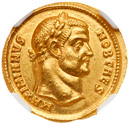 |
Galerius. Gold Aureus (5.36 g) AD 305-311. Mint of Cyzicus (?), struck as Caesar, AD 293. MAXIMIANVS NOB CAES, laureate head facing right. Reverse: CONCORDI-AE AVGG NN, Diocletian and Maximian seated left, each holding a globe and a parazonium, Victory flying above and crowning them (RIC -; Depeyrot 13/5 (these dies); Calicó -; BMC -). Extremely Rare. Well-struck in high relief and lustrous. NGC graded MS, Strike 5/5 Surface 4/5. Value $18,000 - UP
Ex. Classical Numismatic Group, Auction 99, 13 May 2015, lot 716.
View details and enlarged photos
|
|
Lot 250 |
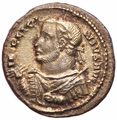 |
Licinius I. BI Argenteus (2.82 g), AD 308-324. Treveri, AD 309-313. IMP LICI-NIVS AVG, laureate, draped and cuirassed bust of Licinius I left, holding thunderbolt and scepter over shoulder. Reverse: IOVI CO-NSERVA-TORI AVG, Jupiter, holding thunderbolt and scepter, seated left on eagle standing right, head upturned left and wings spread; PTR. RIC 825; RSC 99. Very Rare. Virtually as struck and absolutely superb. Pleasing antique toning. Nearly Mint State. Value $2,200 - UP
View details and enlarged photos
|
|
Lot 251 |
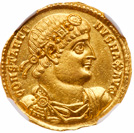 |
Constantine I. Gold Solidus (4.39 g), AD 307/10-337. Antioch, AD 335. CONSTANTI-NVS MAX AVG, diademed, draped and cuirassed bust of Constantine I right. Reverse: VICTORIA CO-NSTANTINI AVG, Victory advancing left, holding trophy and palm branch; SMAN. RIC 96; Depeyrot 45/1. NGC grade MS; Strike: 5/5, Surface: 2/5. Brushed. Value $15,000 - UP
Ex MPM collection and privately bought in 1961.
View details and enlarged photos
|
|
Lot 252 |
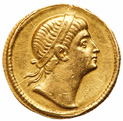 |
Crispus. Gold Solidus (4.37 g), Caesar, AD 317-326. Sirmium, AD 325/6. Diademed head of Crispus right, gazing upward. Reverse: CRISPVS CAESAR, Victory advancing left, holding wreath and palm branch; SIRM. RIC 63; Depeyrot 10/2. Extremely Rare. Portrait of�fine artistic style. We note light scratches in reverse field and rim marks. Nearly Extremely Fine. Value $12,500 - UP
Ex Randolph Laughlin Collection (Hess, December 1933), 1034; Ex Ponton d'Amécourt Collection (Rollin & Feuardant, 14 April 1887), 703.
View details and enlarged photos
|
|
Lot 253 |
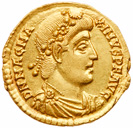 |
Magnus Maximus. Gold Solidus (4.48 g), AD 383-388. Treveri. D N MAG MA-XIMVS P F AVG, diademed, draped and cuirassed bust of Magnus Maximus right. Reverse: RESTITVTOR REIPVBLICAE, emperor standing facing, head right, holding labarum inscribed with a Christogram, and holding Victory on globe; *//SMTR. RIC 76; Depeyrot 50/1 corr. Delicately toned and perfectly centered. Lustrous. Mint State. Value $18,000 - UP
As the son of the notable commander Flavius Julius Eucherius, Magnus Maximus was virtually born into the military profession. He served under Count Theodosius with distinction in Africa (373) and on the Danube frontier (376) but began to develop a reputation for greed and recklessness. In 380, Maximus, who held the post of magister militum per Gallias ("Master of the Army in the Gauls") was dispatched to Britannia to bring order to the troubled island. He defeated an invasion of southern Britannia mounted by the Picts and Caledonians in 381, after which his success seems to have begun to go to his head.
At the same time that Maximus was quelling the northern enemies of Britannia, the popularity of Gratian, the Western Roman Emperor, was at low ebb. Policies designed to settle Christianized Alans (a migrating Iranian people) were perceived as evidence of imperial favoritism at the expense of indigenous citizens of the Roman Empire. Taking advantage of the growing discontent, Maximus proclaimed himself a rival emperor with the support of his troops in 383. He immediately crossed the English Channel to face Gratian in battle. The Western emperor was defeated near Paris and fled to Lyons, but Maximus had him hunted down and killed. He then mounted an invasion of Italy with the intention of overthrowing Gratian's co-emperor, the 12-year-old Valentinian II. He was only prevented from making good on his plans by the timely intervention of a large army sent by Theodosius I, the Eastern emperor, and the entreaties of Ambrose, the famous Bishop of Milan. Subsequent negotiations, which dragged on into 384, ultimately recognized Maximus as Western emperor with Valentinian II as his co-emperor.
Maximus established a new imperial capital at Trier, from which he ruled over Gaul, Britannia, Hispania, and Africa while Valentinian II retained only Italy. He seems to have had greater popularity than his predecessor and was even made the subject of a panegyric by the pagan senator Q. Aurelius Symmachus despite Maximus' strong orthodox Christian beliefs. The latter were loudly expressed in his execution of Priscillian, the wealthy but heretical Bishop of Ávila, and his followers in 385. Two years later, Maximus made a second invasion of Italy, this time forcing Valentinian II to abandon his capital at Milan and flee to Theodosius I in the East.
Unfortunately, Maximus did not have long to enjoy his victory. In the summer of 388, Theodosius I and Valentinian II began to march against him with a large army. Maximus faced them at the Sava River in Pannonia but suffered defeat and fled to Aquileia. He subsequently surrendered and threw himself on the mercy of Theodosius I, but the Eastern emperor was not in a forgiving mood and ordered his execution. The Roman Senate, whose members had praised Maximus not so long before, now decreed a damnatio memoriae against him, throwing down his images and striking his name from inscriptions. His mother and daughters were left unharmed, but his son, Flavius Victor, was strangled in Trier because his father had appointed him as co-emperor, probably in 387.
This attractive gold solidus was struck for Magnus Maximus at Trier not long after he claimed imperial authority for himself. The reverse legend describes him as RESTITVTOR REI PVBLICAE ("Restorer of the State"), probably referring to Maximus' removal of the unpopular Gratian, whose supposed favoritism served to destabilize the Western Roman Empire. He is shown on the reverse as a cuirassed warrior emperor holding Victory in his right hand and the labarum in his left. The latter was a sacred military banner constructed by Constantine the Great and which he had emblazoned with the Chi-Rho monogram of Christ in response to his famous vision in which he was advised in hoc signo vincit ("in this sign conquer"). It subsequently became a talisman of imperial victory that continued in use in battle or in ceremonial form down to the end of the Byzantine Empire.
View details and enlarged photos
|
|
|
|